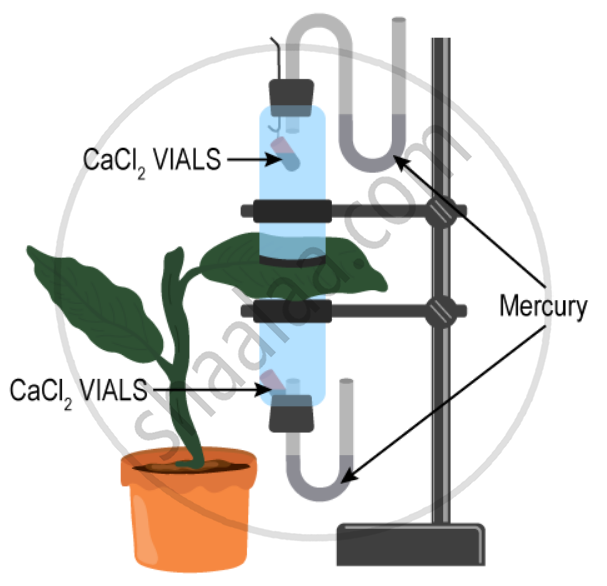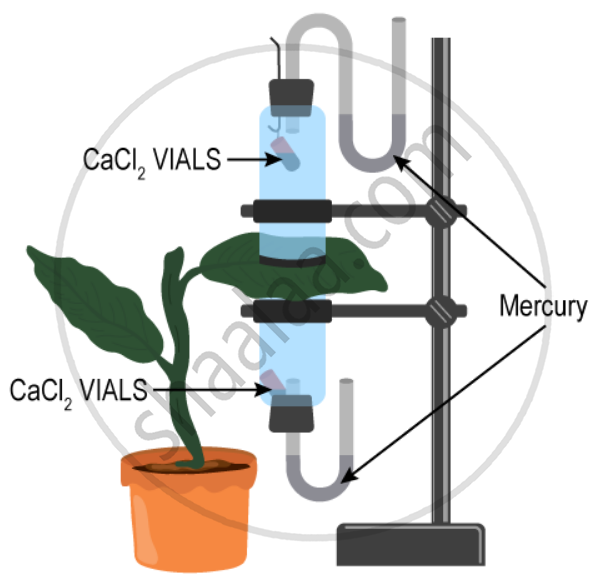Advertisements
Advertisements
प्रश्न
Given below is the diagram of an apparatus used to study a particular phenomenon in plants:

- Name the apparatus.
- What is it used for?
- What is the role played by the air-bubble in this experiment?
- What is the use of the reservoir?
- What happens to the movement of the air-bubble if the apparatus is kept:
- in the dark
- in sunlight
- in front of a fan?
Give a reason in each case.
उत्तर
- Ganong’s potometer
- The rate of transpiration from a leafy shoot is measured using a potometer.
- As transpiration occurs, the air bubble added to the horizontally graded capillary tube goes along. A suction force is created as the water from the twig is lost from the beaker and the bubble in the capillary tube goes along.
- Opening the stopcock releases the water into the capillary tube from the reservoir.
- The movement of air bubbles is affected as follows:
- The stomata, tiny openings on leaves, will close in the absence of light, sometimes known as the dark, therefore preventing transpiration. Thus, the air bubble will remain stationary in one location.
- More transpiration results during the day when the stomata are open to let carbon dioxide enter for photosynthesis. Transpiration lessens at night as the stomata close. As a result of the higher water loss throughout the day, the air bubble travels more.
- Placing the equipment before the fan speeds up transpiration. This causes the air bubble to migrate more since the quicker air from the fan removes more water vapour, promoting more transpiration.
APPEARS IN
संबंधित प्रश्न
Name the following:
The apparatus to record the rate of transpiration in a cut shoot.
What is lenticular transpiration? Mention one major difference between lenticular transpiration and stomatal transpiration.
Droplets of water may sometimes be seen along the margins of the leaves of a banana plant, growing in wet soil, in the mornings. Are these dew drops? Comment upon your answer.
Given below is the diagram of an apparatus used to study a particular phenomenon in plants:

What is the use of the reservoir?
The apparatus shown in the following diagram is Garreau’s potometer designed to demonstrate unequal transpiration from the two surfaces of a dorsiventral leaf Before keeping the leaf in between the cups, anhydrous calcium chloride (CaCl2) contained in two small vials were weighed and placed in both the cups. The ends of the cups were closed with corks through which two mercury manometers were connected. After few hours, CaCl2 vials were taken out and weighed again.

What is the purpose of keeping CaCl2 vials inside the cup?
The apparatus shown in the following diagram is Garreau’s potometer designed to demonstrate unequal transpiration from the two surfaces of a dorsiventral leaf. Before keeping the leaf in between the cups, anhydrous calcium chloride (CaCl2) contained in two small vials were weighed and placed in both the cups. The ends of the cups were closed with corks through which two mercury manometers were connected. After few hours, CaCl2 vials were taken out and weighed again.

After few hours CaCl2 vials were taken out and weighed again. Will you expect any difference in weight? If so, give reason.
Mention, if the following statement is True or False. If false rewrite the wrong statement in its correct form:
Potometer is an instrument, used for measuring the rate of transpiration
The apparatus used to measure the rate of transpiration is ______.
Match the terms given in column A with column B:
| Column A | Column B | ||
| (a) | Hydathodes | (i) | Photosynthesis |
| (b) | Stomata | (ii) | Respiration |
| (c) | Cuticle | (iii) | Regulates opening and closing of stomata |
| (d) | Lenticels | (iv) | Reduces loss of water |
| (e) | Guard cells | (v) | Guttation |
Name four kinds of potometers on the basis of the names of the scientists who discovered them.
